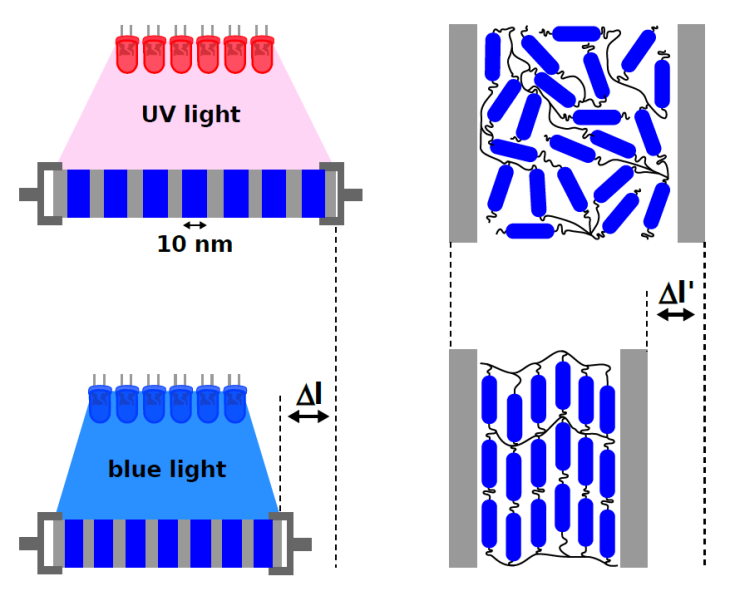Light-directed phases of liquid crystalline elastomers in nanoporous solids for materials with responsive photo-elasticity and actuorics / PhotoNaS
- Project duration 11/2020 - 11/2021
- Project partner 1 Prof. Dr. Patrick Huber, Institute for Materials and X-Ray Physics, Technische Universität Hamburg (TUHH)
- Project partner 2 Prof. Dr. Robert Blick, Center for Hybrid Nanostructure, Universität Hamburg (UHH)
- Project partner 3 Prof. Dr. Norbert Huber, Institut für Werkstoffmechanik, Helmholz-Zentrum Hereon (Hereon)

Figure: Photo-elasticity in a nanoporous medium with light-directed phase behavior of liquidcrystalline elastomers on the single-pore scale. Illumination with UV or blue light leads to an isotropic or nematic state and thus swelling or tensile pore-loading pressures on the single-pore scale. This results in a photo-responsive expansion or contraction of the macroscopic nanoporous solid, respectively. Foto: TUHH/P. Huber
Self-organized nanoporosity in solids combining hard matter, such as silicon, with soft matter e.g. polymers and liquid crystals, provides the means to form materials with novel morphologies, tailorable in size and shape, which can dynamically adapt their structures and functions to the environment. Exploitation of new “nano”-physical hybrids is already beginning to revolutionize technologies ranging from water filtering, DNA sequencing to energy harvesting, transformation and storage. However, despite the existence of much theoretical work, there is still no predictive understanding of how to design stimuli-responsive nanoporous materials, due to the complex interplay of geometrical confinement effects and soft-hard interfacial interactions as well as the extreme experimental demands to study matter in single nanopores.
PhotoNaS aims to achieve predictive understanding of novel photo-elastic phases actively and reversibly switchable by photonic stimuli at will. The resulting hybrids are expected to exhibit light-controllable actuoric behavior. PhotoNaS shall strengthen the interaction between the TUHH, UHH, and HZG within the ZHM towards a future collaborative research initiative (SFB) on responsive and dynamically adaptive hybrid materials. Thus, it will be an important preparatory ZHM collaboration for the SFB initiative on Active Integrated Materials - AIMAt.

